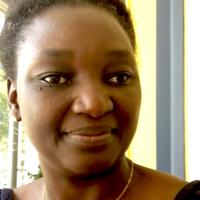
Reading time 5 min
Esther Dzalé, she's got (algo)rhythm
Published on 06 July 2018
The path that led Esther to INRAE was not a straight one. She began her studies in Burkina Faso, where she completed a science-stream baccalauréat, and then a year of physics and chemistry at the University of Ouagadougou before successfully sitting a competitive examination to enter Africa’s first international university for computer science in Libreville, Gabon in 1993. After receiving her degree in programming and analysis, she went on to study information technology, which took her to France for the first time and into the world of research, with an internship at a CNRS laboratory in Toulouse. “Then, I had the opportunity to take a training course in Clermont-Ferrand with an internship in a bio-tech start-up, which I loved. This brought me to IRISA in Rennes, where I help to set up the BioGenOuest bioinformation system.”
Exemplary expertise
I've always believed in being useful wherever I am
In 2005, Esther came to INRAE as a research and development engineer for applications at the Delegation for Scientific and Technical Information (DIST). It was a two-for-one new job. “I successfully sat the competitive examination for DIST just as I had been recruited as a data administrator at the Genomics–Informatics Research at INRAE Versailles on a three-year contract. In the end, I only stayed two months.”
Between 2005 and 2008, Esther worked on ProdINRA, the Institute’s open archive for its scientific publications. “The project was already underway; I worked on aspects of design and management to help both the IT project manager and the project leader. I quickly realised that I needed to work on several projects at once.”
The only computer scientist working in DIST at the time, she jointly managed its technology resource skills centre. “The aim was to explore technologies that were relevant to our work, test them, then put them into practice.” From its earliest days, she was also interested in the semantic web, a field of study looking at the way people access information on the Internet in order to provide findings that are explicit, contextual and interconnected. “At first, my colleagues felt the field was too technical, or that it fell outside the scope of their work. Over time, I’ve managed to get them interested and to improve their skills in this area. It gives me a lot of satisfaction.”
Sharing data
Starting in 2013, Esther became increasingly interested in data sharing. She worked with the Research Data Alliance, an international organisation with over 7100 members, researchers and science data professionals in 137 countries, to develop collective data sharing systems. “Initially, I was just there to listen and help out a bit. But quite quickly, I was asked to lead a working group on data interoperability for wheat. Not really knowing much about wheat, I felt rather out of place, but it was a really great experience in the end. I was able to bring together skills in information technology, bioinformatics and IST to produce a practical guide on wheat data interoperability.” Esther continues to take a broader leadership role in the field of agricultural data. She is involved in a wide range of INRAE projects, including leading several working groups and creating the IST digital resource skills centre. As director of DIST since 2017, she is helping to shape the Institute’s data policies and is introducing new tools and services. She has recently managed a number of successful projects through the use of digital object identifiers (DOI), which are unique alphanumeric codes scientists assign to their publications to better manage them in bibliographic databases and in INRAE’s science data management system, Data INRAE. “These changes are part of a cultural shift at INRAE towards open science. I’m proud to stand with our scientists and be a part of it.
- 45 years old, married, with two children
- Since September 2017: Director of the Delegation for Scientific and Technical Information (DIST), INRA Île-de-France Versailles-Grignon
- 2016–2017: executive certificate in big data for business, CentraleSupélec, Paris
- 2012–2017: project manager, project design assistance, coordinator of research data skills resource centre, INRA Île-de-France Versailles-Grignon
- 2005–2011: research and development engineer for applications, DIST, INRA Île-de-France Versailles-Grignon
- 2002–2005: senior database engineer for BioGenOuest information system, IRISA, INRIA
- 2002: university degree with specialisation in research, information and communication systems, business intelligence focus, ISIMA, Clermont-Ferrand
- 2000: computer science degree, Institut Africain d'Informatique (IAI - African Computer Science Institute), Libreville
- 1996: programming and analysis degree, Institut Africain d'Informatique (IAI - African Computer Science Institute), Libreville
- Hobby : Likes to walk in her free time
